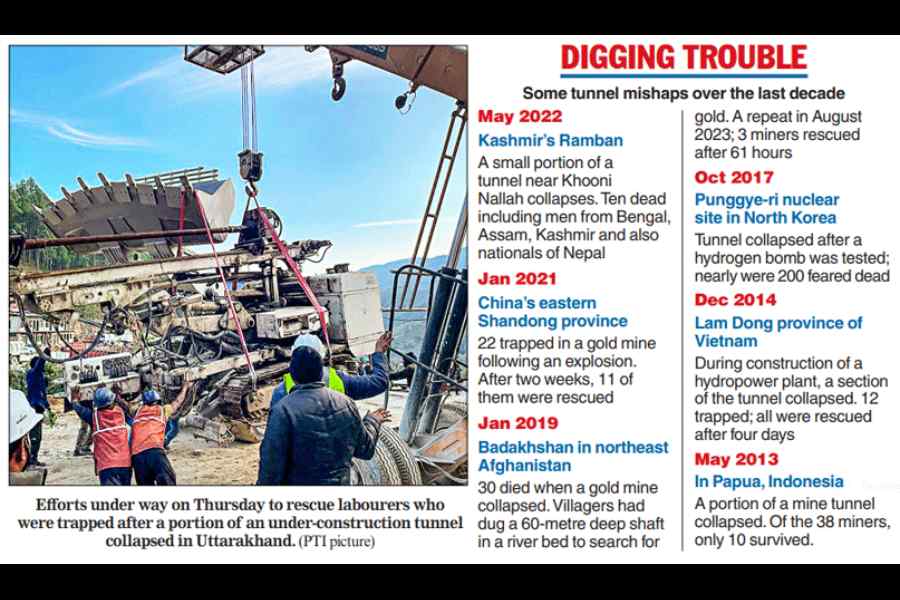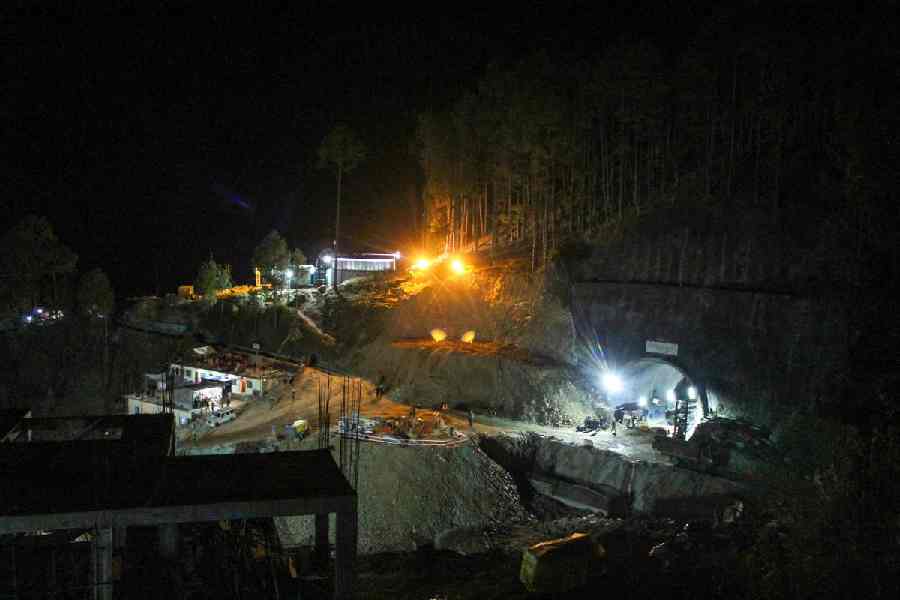Close to 100 hours since 40 labourers got trapped inside an under-construction tunnel in Uttarkashi, the government said it could take another two-three days to execute the rescue operation.
A heavy-duty drilling machine flown in by the IAF from Delhi began boring through the rubble of the collapsed tunnel on the Char Dham route in Uttarakhand on Thursday in a fresh attempt to create an escape passage with steel pipes for the labourers trapped since Sunday morning.
Union minister of state for road transport and highways V.K. Singh visited the site in Silkyara village and later told a news conference: “Keeping in view the ground situation, we could need two-three days more to complete the rescue operation. It may take less time but we must remember that it is only a machine that we have brought here.”
Singh added: “It could be that a part of it would break or develop a snag during the operation. However, we are bringing every possible component of the drill machine here so that any damaged part can be replaced immediately. We are also in touch with experts from across the world and working in close coordination with them.”
About 60 metres of the tunnel on the Yamunotri National Highway collapsed around 5.30am on Sunday following a landslide, trapping 40 workers within a 240m stretch of the tunnel whose other side is yet to be constructed.
“I have been told that the new drilling machine has already penetrated 5-7 metres through the debris. We hope it would soon reach the trapped workers, drilling at the rate of 5-10 metres every hour,” chief minister Pushkar Dhami told reporters in Dehradun.
“All the workers are safe. We are providing them oxygen and food through the water pipes laid there during the construction of the tunnel. The situation is difficult but we are trying to bring them out safely,” he added.

At the media conference, Union minister Singh was asked why no assessment study had been carried out at the mountain site before such a big project was launched. He replied: “Sensors were put up there for such assessments and the mountain was stable for the last four-and-a-half years.”
Reminded that a minor landslide had occurred inside the construction site last month and a small stretch of the tunnel had collapsed, Singh appeared to lose his cool and said: “Did we know before that the mountain will fall? The work was done according to the DPR (detailed project report).”
Disagreeing that the rescuers had wasted four days, the minister said: “In fact, it is a new mountain where there is more soil and less rock. The auger of the previous drill machine had broken and this was the reason we replaced it with a heavy drill machine. We are thinking positively about our success.”
The new machine, which has reverse blades to cut through debris, is to simultaneously push the steel hume pipes one after another inside the tunnel to make a passage for the trapped workers to crawl out. The debris that is cleared is to be continuously brought out of the tunnel in trucks.
A Hindi press release issued by the state government on Thursday listed the equipment and manpower deployed in the rescue operation but remained silent on the time it could take to bring out the labourers.
It said a vertical and a horizontal drill machine, three pokland machines, two JCBs, six trucks, one hydra and two loader machines were working at the mouth of the tunnel.
“There are four poklands, three shotcretes, two boomers, two hydras and two trucks inside the tunnel…. There are 160 rescue workers,” the release added.
Adesh Jain, an engineer who worked with the previous auger drill machine that had developed a snag before it could start work on Tuesday, had given a grim picture of the situation on Wednesday. He had said the collapsed area, 60 metres initially, had increased in the last two days as 10 metres of the tunnel had fallen again on Tuesday when they were trying to drill through the debris.
A source in the government feared it could take more time than claimed by the Union minister to reach the trapped labourers.
“They are saying that it takes one hour to drill a 6m-long hume pipe into the rubble but nobody is revealing that welding another hume pipe to it takes more than two hours. As far as I know, the first pipe was drilled successfully by 2pm on Thursday and the process to connect the second pipe had started,” said an officer of the disaster management authority of the Uttarakhand government.
“To insert each pipe and link it with another will take a total of three to three-and-a-half hours. Workers who were not on duty on Sunday have informed the government that the trapped labourers had gone in with two heavy machines and two trucks. Removing these in case they come in the way of the hume pipes would take no less than six-seven hours,” the official added.











